Abstract
Infant hamsters of different ages were examined for their susceptibility to enteric Clostridium difficile colonization. Intragastric administration of C. difficile to infant hamsters resulted in multiplication of the organism in the intestinal tracts of animals 4 to 12 days old; hamsters younger or older were resistant to C. difficile intestinal colonization. Toxicity to the colonized animals could not be demonstrated despite cytotoxin titers in some infant hamsters comparable to titers found in the intestinal tracts of adult hamsters with C. difficile-associated intestinal disease. When introduced into 4-day-old hamsters, C. difficile colonized the intestinal tract and remained at high levels until the animals were 13 days old, at which time the presence of intestinal C. difficile could no longer be demonstrated. The number of C. difficile required to colonize the intestinal tracts of 50% of 7-day-old hamsters was 18 viable cells. On the other hand, 10(8) viable cells of C. difficile failed to colonize the intestinal tracts of healthy, non-antibiotic-treated adult hamsters.
Full text
PDF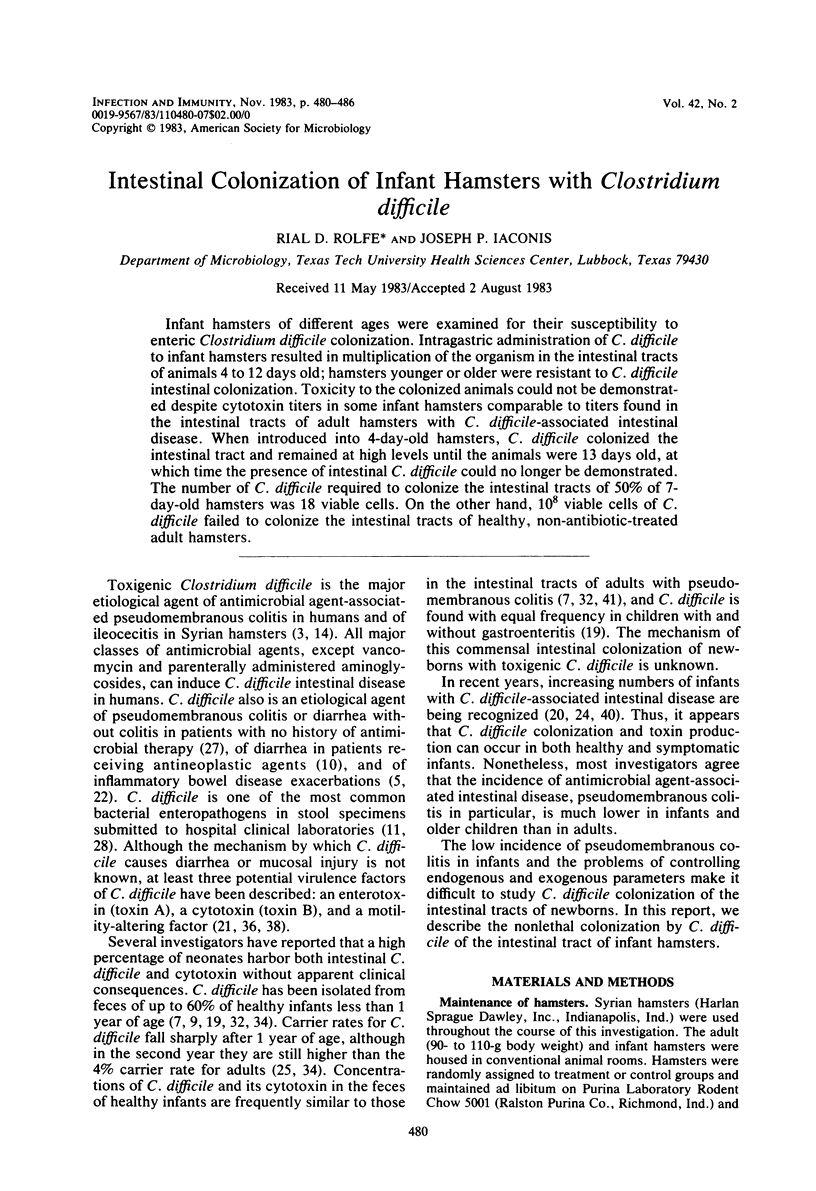
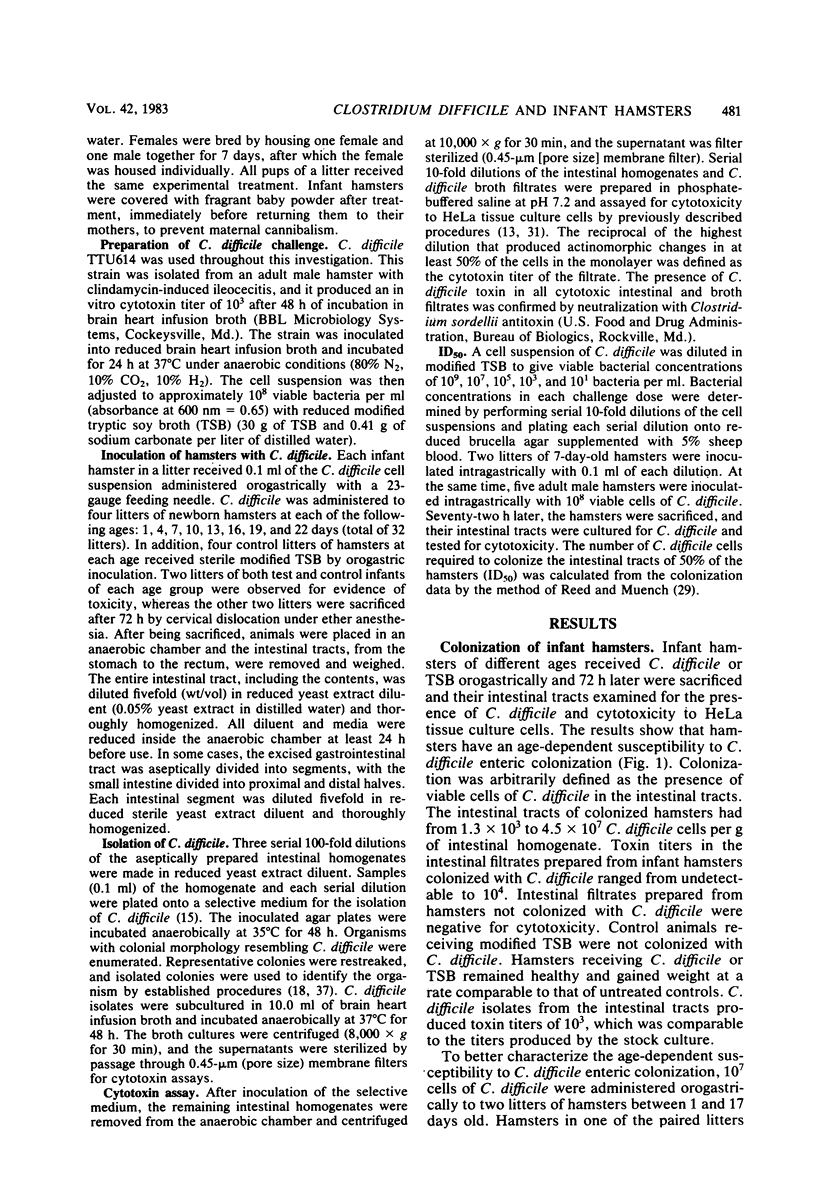
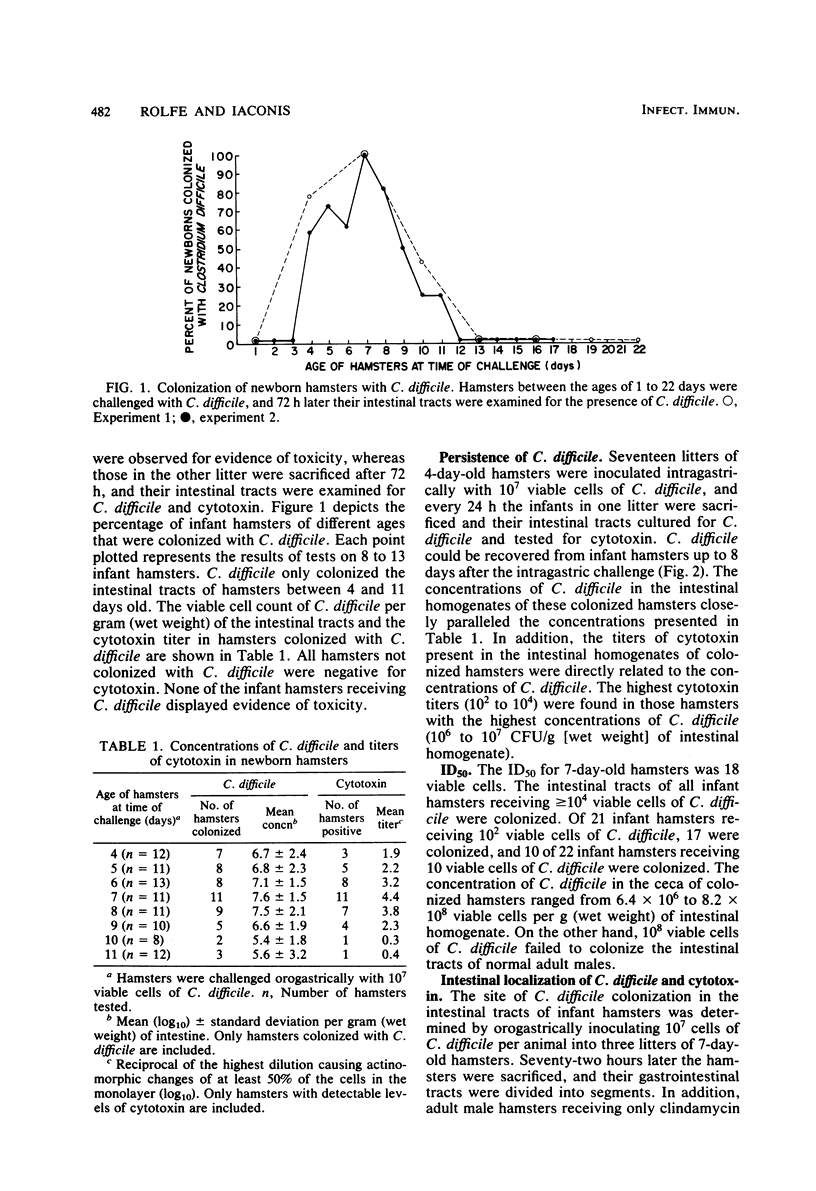
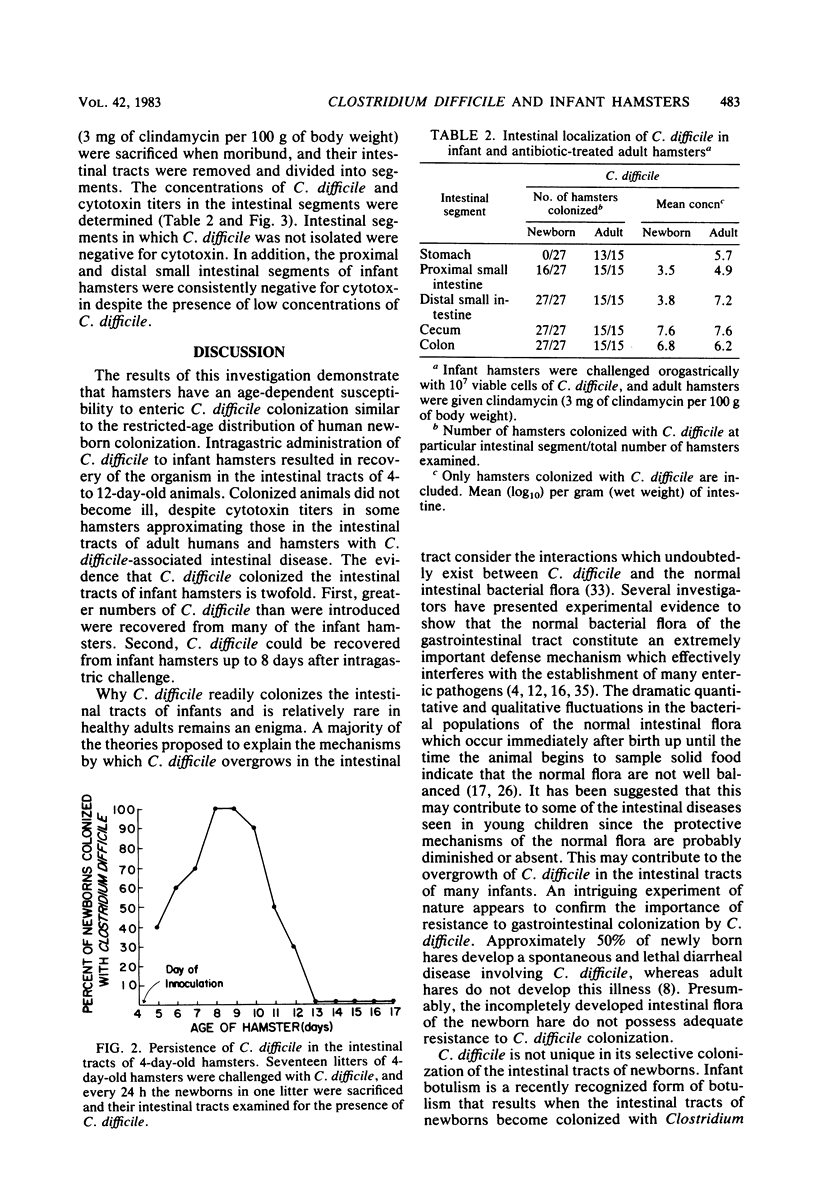
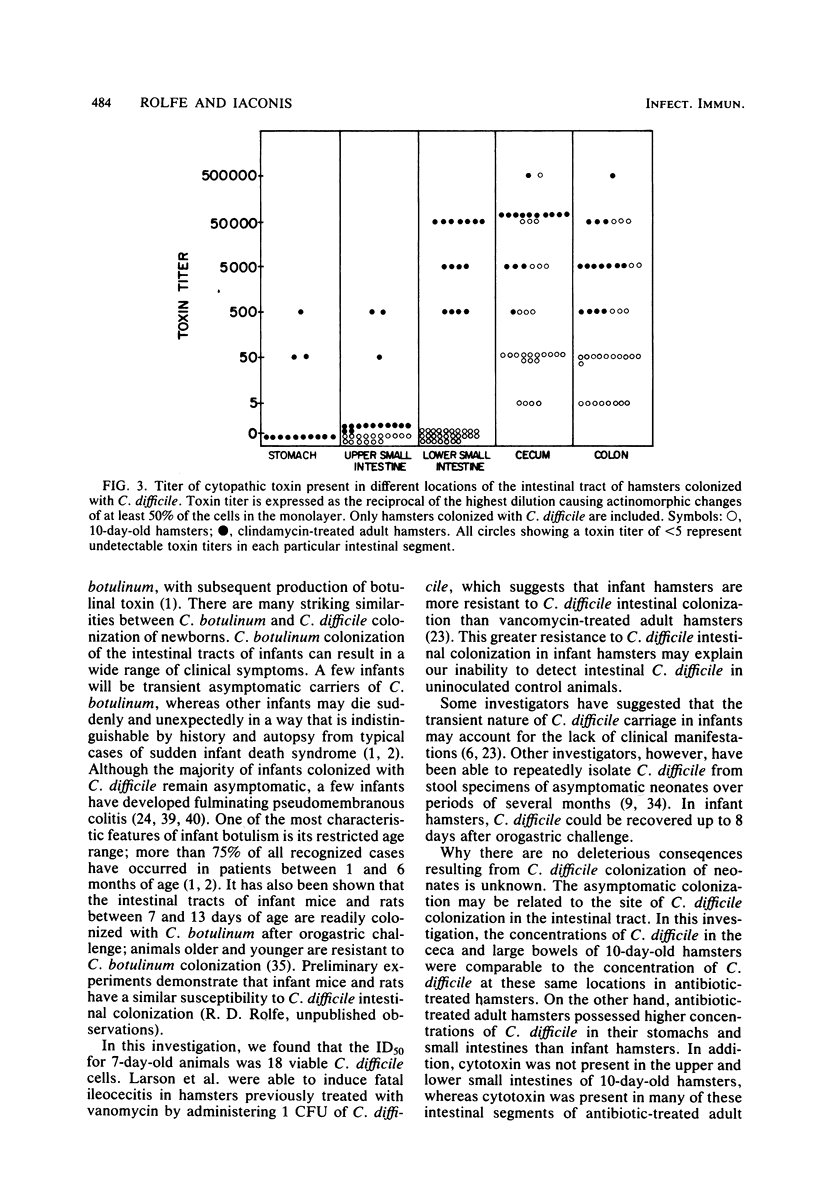
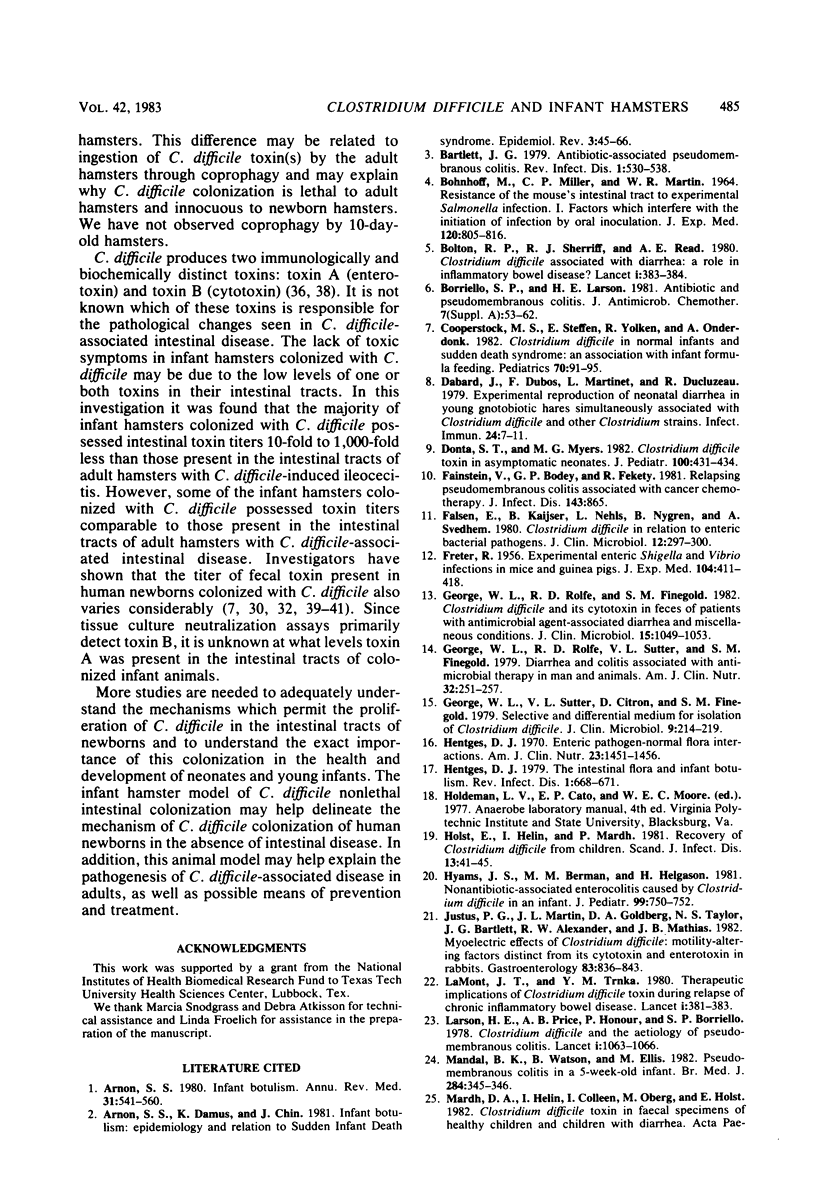
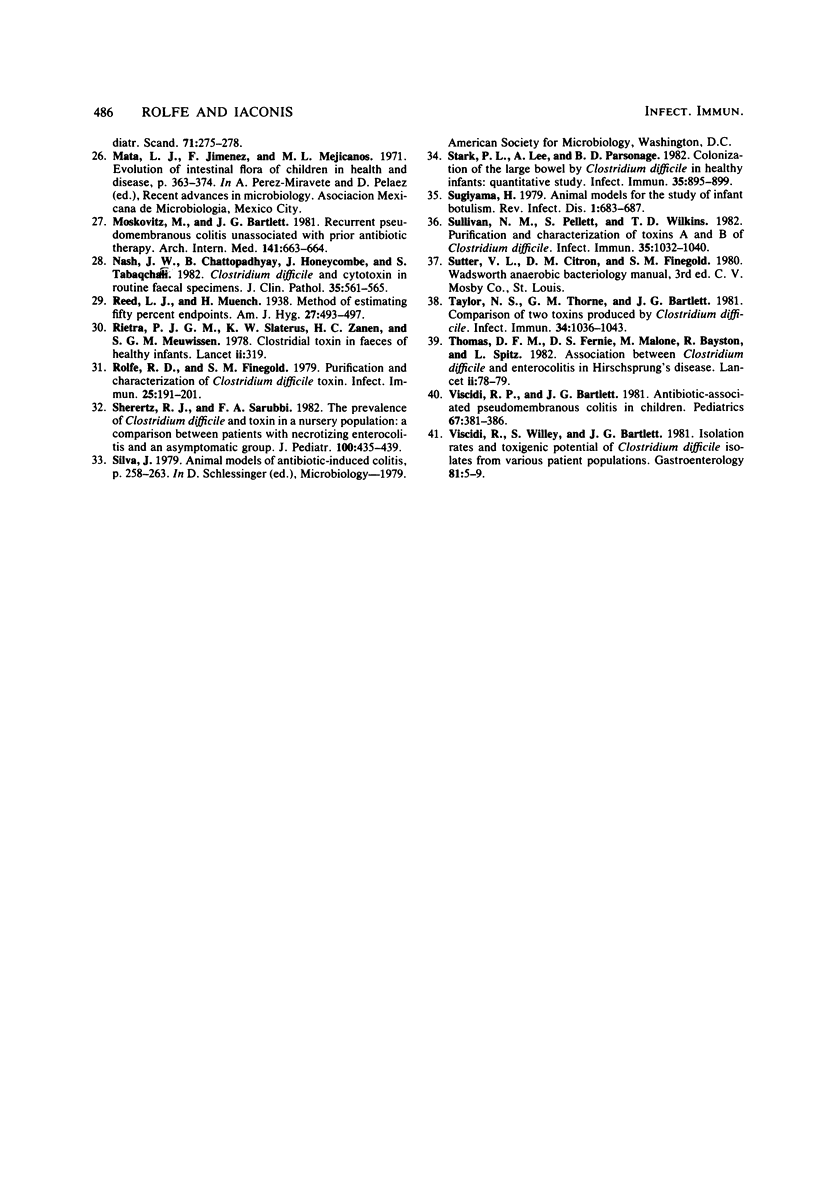
Selected References
These references are in PubMed. This may not be the complete list of references from this article.
- Arnon S. S., Damus K., Chin J. Infant botulism: epidemiology and relation to sudden infant death syndrome. Epidemiol Rev. 1981;3:45–66. doi: 10.1093/oxfordjournals.epirev.a036239. [DOI] [PubMed] [Google Scholar]
- Arnon S. S. Infant botulism. Annu Rev Med. 1980;31:541–560. doi: 10.1146/annurev.me.31.020180.002545. [DOI] [PubMed] [Google Scholar]
- BOHNHOFF M., MILLER C. P., MARTIN W. R. RESISTANCE OF THE MOUSE'S INTESTINAL TRACT TO EXPERIMENTAL SALMONELLA INFECTION. I. FACTORS WHICH INTERFERE WITH THE INITIATION OF INFECTION BY ORAL INOCULATION. J Exp Med. 1964 Nov 1;120:805–816. doi: 10.1084/jem.120.5.805. [DOI] [PMC free article] [PubMed] [Google Scholar]
- Bartlett J. G. Antibiotic-associated pseudomembranous colitis. Rev Infect Dis. 1979 May-Jun;1(3):530–539. doi: 10.1093/clinids/1.3.530. [DOI] [PubMed] [Google Scholar]
- Bolton R. P., Sherriff R. J., Read A. E. Clostridium difficile associated diarrhoea: a role in inflammatory bowel disease? Lancet. 1980 Feb 23;1(8165):383–384. doi: 10.1016/s0140-6736(80)90940-x. [DOI] [PubMed] [Google Scholar]
- Borriello S. P., Larson H. E. Antibiotic and pseudomembranous colitis. J Antimicrob Chemother. 1981 Jun;7 (Suppl A):53–65. doi: 10.1093/jac/7.suppl_a.53. [DOI] [PubMed] [Google Scholar]
- Cooperstock M. S., Steffen E., Yolken R., Onderdonk A. Clostridium difficile in normal infants and sudden infant death syndrome: an association with infant formula feeding. Pediatrics. 1982 Jul;70(1):91–95. [PubMed] [Google Scholar]
- Dabard J., Dubos F., Martinet L., Ducluzeau R. Experimental reproduction of neonatal diarrhea in young gnotobiotic hares simultaneously associated with Clostridium difficile and other Clostridium strains. Infect Immun. 1979 Apr;24(1):7–11. doi: 10.1128/iai.24.1.7-11.1979. [DOI] [PMC free article] [PubMed] [Google Scholar]
- Donta S. T., Myers M. G. Clostridium difficile toxin in asymptomatic neonates. J Pediatr. 1982 Mar;100(3):431–434. doi: 10.1016/s0022-3476(82)80454-x. [DOI] [PubMed] [Google Scholar]
- FRETER R. Experimental enteric Shigella and Vibrio infections in mice and guinea pigs. J Exp Med. 1956 Sep 1;104(3):411–418. doi: 10.1084/jem.104.3.411. [DOI] [PMC free article] [PubMed] [Google Scholar]
- Fainstein V., Bodey G. P., Fekety R. Relapsing pseudomembranous colitis associated with cancer chemotherapy. J Infect Dis. 1981 Jun;143(6):865–865. doi: 10.1093/infdis/143.6.865. [DOI] [PubMed] [Google Scholar]
- Falsen E., Kaijser B., Nehls L., Nygren B., Svedhem A. Clostridium difficile in relation to enteric bacterial pathogens. J Clin Microbiol. 1980 Sep;12(3):297–300. doi: 10.1128/jcm.12.3.297-300.1980. [DOI] [PMC free article] [PubMed] [Google Scholar]
- George W. L., Rolfe R. D., Finegold S. M. Clostridium difficile and its cytotoxin in feces of patients with antimicrobial agent-associated diarrhea and miscellaneous conditions. J Clin Microbiol. 1982 Jun;15(6):1049–1053. doi: 10.1128/jcm.15.6.1049-1053.1982. [DOI] [PMC free article] [PubMed] [Google Scholar]
- George W. L., Rolfe R. D., Sutter V. L., Finegold S. M. Diarrhea and colitis associated with antimicrobial therapy in man and animals. Am J Clin Nutr. 1979 Jan;32(1):251–257. doi: 10.1093/ajcn/32.1.251. [DOI] [PubMed] [Google Scholar]
- George W. L., Sutter V. L., Citron D., Finegold S. M. Selective and differential medium for isolation of Clostridium difficile. J Clin Microbiol. 1979 Feb;9(2):214–219. doi: 10.1128/jcm.9.2.214-219.1979. [DOI] [PMC free article] [PubMed] [Google Scholar]
- Hentges D. J. Enteric pathogen--normal flora interactions. Am J Clin Nutr. 1970 Nov;23(11):1451–1456. doi: 10.1093/ajcn/23.11.1451. [DOI] [PubMed] [Google Scholar]
- Hentges D. J. The intestinal flora and infant botulism. Rev Infect Dis. 1979 Jul-Aug;1(4):668–673. doi: 10.1093/clinids/1.4.668. [DOI] [PubMed] [Google Scholar]
- Holst E., Helin I., Mårdh P. A. Recovery of Clostridium difficile from children. Scand J Infect Dis. 1981;13(1):41–45. doi: 10.1080/00365548.1981.11690365. [DOI] [PubMed] [Google Scholar]
- Hyams J. S., Berman M. M., Helgason H. Nonantibiotic-associated enterocolitis caused by Clostridium difficile in an infant. J Pediatr. 1981 Nov;99(5):750–752. doi: 10.1016/s0022-3476(81)80402-7. [DOI] [PubMed] [Google Scholar]
- Justus P. G., Martin J. L., Goldberg D. A., Taylor N. S., Bartlett J. G., Alexander R. W., Mathias J. R. Myoelectric effects of Clostridium difficile: motility-altering factors distinct from its cytotoxin and enterotoxin in rabbits. Gastroenterology. 1982 Oct;83(4):836–843. [PubMed] [Google Scholar]
- LaMont J. T., Trnka Y. M. Therapeutic implications of Clostridium difficile toxin during relapse of chronic inflammatory bowel disease. Lancet. 1980 Feb 23;1(8165):381–383. doi: 10.1016/s0140-6736(80)90939-3. [DOI] [PubMed] [Google Scholar]
- Larson H. E., Price A. B., Honour P., Borriello S. P. Clostridium difficile and the aetiology of pseudomembranous colitis. Lancet. 1978 May 20;1(8073):1063–1066. doi: 10.1016/s0140-6736(78)90912-1. [DOI] [PubMed] [Google Scholar]
- Mandal B. K., Watson B., Ellis M. Pseudomembranous colitis in a 5-week-old infant. Br Med J (Clin Res Ed) 1982 Jan 30;284(6312):345–346. doi: 10.1136/bmj.284.6312.345-c. [DOI] [PMC free article] [PubMed] [Google Scholar]
- Moskovitz M., Bartlett J. G. Recurrent pseudomembranous colitis unassociated with prior antibiotic therapy. Arch Intern Med. 1981 Apr;141(5):663–664. [PubMed] [Google Scholar]
- Nash J. Q., Chattopadhyay B., Honeycombe J., Tabaqchali S. Clostridium difficile and cytotoxin in routine faecal specimens. J Clin Pathol. 1982 May;35(5):561–565. doi: 10.1136/jcp.35.5.561. [DOI] [PMC free article] [PubMed] [Google Scholar]
- Rietra P. J., Slaterus K. W., Zanen H. C., Meuwissen S. G. Clostridial toxin in faeces of healthy infants. Lancet. 1978 Aug 5;2(8084):319–319. doi: 10.1016/s0140-6736(78)91723-3. [DOI] [PubMed] [Google Scholar]
- Rolfe R. D., Finegold S. M. Purification and characterization of Clostridium difficile toxin. Infect Immun. 1979 Jul;25(1):191–201. doi: 10.1128/iai.25.1.191-201.1979. [DOI] [PMC free article] [PubMed] [Google Scholar]
- Sherertz R. J., Sarubbi F. A. The prevalence of Clostridium difficile and toxin in a nursery population: a comparison between patients with necrotizing enterocolitis and an asymptomatic group. J Pediatr. 1982 Mar;100(3):435–439. doi: 10.1016/s0022-3476(82)80455-1. [DOI] [PubMed] [Google Scholar]
- Stark P. L., Lee A., Parsonage B. D. Colonization of the large bowel by Clostridium difficile in healthy infants: quantitative study. Infect Immun. 1982 Mar;35(3):895–899. doi: 10.1128/iai.35.3.895-899.1982. [DOI] [PMC free article] [PubMed] [Google Scholar]
- Sugiyama H. Animal models for the study of infant botulism. Rev Infect Dis. 1979 Jul-Aug;1(4):683–688. doi: 10.1093/clinids/1.4.683. [DOI] [PubMed] [Google Scholar]
- Sullivan N. M., Pellett S., Wilkins T. D. Purification and characterization of toxins A and B of Clostridium difficile. Infect Immun. 1982 Mar;35(3):1032–1040. doi: 10.1128/iai.35.3.1032-1040.1982. [DOI] [PMC free article] [PubMed] [Google Scholar]
- Taylor N. S., Thorne G. M., Bartlett J. G. Comparison of two toxins produced by Clostridium difficile. Infect Immun. 1981 Dec;34(3):1036–1043. doi: 10.1128/iai.34.3.1036-1043.1981. [DOI] [PMC free article] [PubMed] [Google Scholar]
- Thomas D. F., Fernie D. S., Malone M., Bayston R., Spitz L. Association between Clostridium difficile and enterocolitis in Hirschsprung's disease. Lancet. 1982 Jan 9;1(8263):78–79. doi: 10.1016/s0140-6736(82)90216-1. [DOI] [PubMed] [Google Scholar]
- Viscidi R. P., Bartlett J. G. Antibiotic-associated pseudomembranous colitis in children. Pediatrics. 1981 Mar;67(3):381–386. [PubMed] [Google Scholar]
- Viscidi R., Willey S., Bartlett J. G. Isolation rates and toxigenic potential of Clostridium difficile isolates from various patient populations. Gastroenterology. 1981 Jul;81(1):5–9. [PubMed] [Google Scholar]


